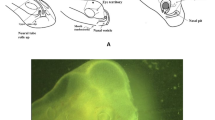Summary
The present paper chiefly reports on our findings in the appendicular skeleton of man; these are supplemented by results obtained on the appendicular skeleton of Felis and Canis. The three-dimensional topography existing in the region of the epiphysis and the epiphyseal cartilage was investigated in the large long bones of Bos taurus.
In the epiphyseal cartilage, electric polarization is clearly detectable. The directions of polarization ran roughly at right angles to the outer surfaces, remaining unchanged in the large long bones from the time of birth until the termination of longitudinal growth, i.e. until ossification of this region. In man — and probably in the other Eutheria, too — the epiphyseal cartilage of the large long bones is therefore characterized by being “permanently polarized”, not only in the physical but also in the physiological sense.
In the diaphysis the directions of polarization existing at the juvenile stage become reversed through 180° in the course of ontogenesis. This process corresponds to the reversal process in the appendicular skeleton of the other Mammalia, the Aves, and the Crocodilia.
During the growth period the bony epiphysis undergoes only relative changes in the form of an increase in size; the existing directions of polarization, however, remain unchanged and do not reverse.
As regards the human appendicular skeleton the results deviate in some respects from the development pattern of the electric polarization phenomena in the ascending order of vertebrates and particularly in the Eutheria. The phenomenon of antiparallel longitudinal polarization was investigated.
Zusammenfassung
Es werden im wesentlichen die Ergebnisse am Extremitätenskelet des Menschen dargestellt, ergänzt durch die Befunde am Extremitätenskelet von Felis und Canis. Die dreidimensionale elektrische Topographie im Bereich der Epiphyse und der Epiphysenfuge wird an den großen Röhrenknochen von Bos taurus untersucht.
Im Knorpel der Epiphysenfuge besteht eine klar ausgeprägte elektrische Polarisation, deren Richtung senkrecht zu ihren Begrenzungsflächen verläuft. Die Polarisationsrichtung innerhalb der Epiphysenfuge bleibt von der Geburt bis zum Abschluß des Längenwachstums der Röhrenknochen, also bis zur Ossifikation dieser Zone, unverändert. Die Epiphysenfuge in den großen Röhrenknochen des Menschen, und wahrscheinlich auch der übrigen Eutheria, weist also nicht nur im physikalischen, sondern auch im physiologischen Sinne eine permanente Polarisation auf.
Innerhalb der Diaphyse tritt beim Menschen im Laufe der Ontogenese eine Umkehrung der im juvenilen Alter vorhandenen Polarisationsrichtungen um 180° ein. Die Umkehrung der elektrischen Polarisationsrichtungen entspricht derjenigen bei den übrigen Mammalia, bei den Aves und Crocodilia, wie sie in vorausgegangenen Mitteilungen dargestellt wurde.
In der knöchernen Epiphyse treten während der Wachstumsperiode nur relative Veränderungen durch Zunahme der Größendimensionen auf; es erfolgt jedoch keine Umkehrung vorhandener Polarisationsrichtungen.
Einige Abweichungen der Untersuchungsergebnisse im menschlichen Extremitätenskelet von dem Entwicklungsschema der elektrischen Polarisationsverhältnisse in der aufsteigenden Vertebratenreihe und speziell bei den Eutheria, sowie die Erscheinung der antiparallelen Längspolarisation in den Röhrenknochen werden besprochen.
Similar content being viewed by others
References
Athenstaedt, H.: Das pyroelektrische Verhalten und das permanente elektrische Moment von menschlichem und tierischem Sehnengewebe. Z. Zellforsch. 81, 62–73 (1967).
— Permanent electric polarization and pyroelectric behavior of the vertebrate skeleton. I. The axial skeleton of the vertebrates (excluding mammalia). Z. Zellforsch. 91, 135–152 (1968a).
— Permanent electric polarization and pyroelectric behaviour of the vertebrate skeleton. II. The axial skeleton of the mammalia. Z. Zellforsch. 92, 428–446 (1968b).
— Permanent electric polarization and pyroelectric behaviour of the vertebrate skeleton. III. The axial skeleton of man. Z. Zellforsch. 93, 484–504 (1969a).
— Permanent electric polarization and pyroelectric behaviour of the vertebrate skeleton. IV. The cranial bones of man. Z. Zellforsch. 97, 537–548 (1969b).
— Permanent electric polarization of the meninges of man. Z. Zellforsch. 98, 300–322 (1969c).
— Permanent electric polarization and pyreolectric behaviour of the vertebrate skeleton. V. The appendicular skeleton of the vertebrates (excluding man). Z. Anat. Entwickl.-Gesch. 131, 1–20 (1970a)
Author information
Authors and Affiliations
Additional information
With support from the Deutsche Forschungsgemeinschaft which is gratefully acknowledged.
Rights and permissions
About this article
Cite this article
Athenstaedt, H. Permanent electric polarization and pyroelectric behaviour of the vertebrate skeleton. Z. Anat. Entwickl. Gesch. 131, 21–30 (1970). https://doi.org/10.1007/BF00518812
Received:
Issue Date:
DOI: https://doi.org/10.1007/BF00518812




